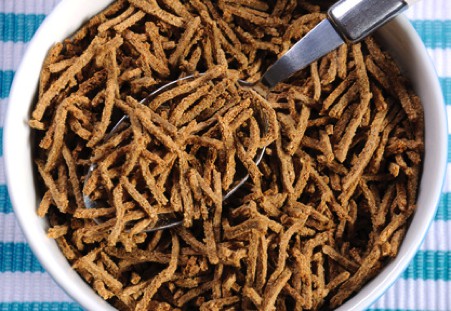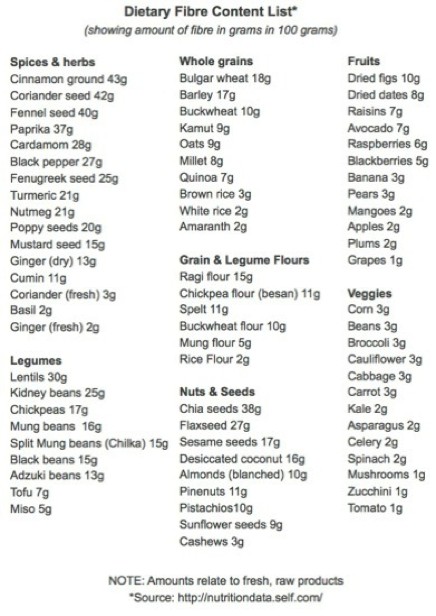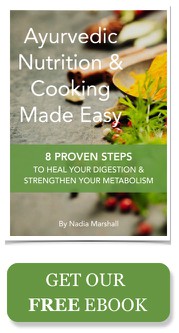By Nadia Marshall
One of my favourite Ayurvedic authors, Dr John Douillard, recently wrote about fibre in his email newsletter. He mentioned that, ‘ancient humans ate 100 grams of fiber per day, compared to a healthy modern human who has to make a special effort to get 20+ grams a day’ and went on to rave about the virtues of eating more fibre (and fat) (1). This left me wondering... how much fibre do I get in my Ayurvedic diet and... is it enough?
I know very little about dietary fibre and have never really given it much thought because since moving to an Ayurvedic way of eating about 11 years ago, I’ve been very ‘regular’, shall we say. The only times I’m not is when I go camping, on holidays or on retreat - it seems when I deeply relax it takes a 2-3 days to adjust to purely Para-sympathetic Nervous System (i.e. restful) movements!
It’s important to note that fibre isn’t just about alleviating constipation. It also helps to:
- slow down the movement of food through the stomach (depending on the type of fibre)
- improve intestinal functioning generally
- feed the good bacteria in the gut
- buffer the absorption of sugar into the bloodstream (meals high in fibre have a lower glycemic index)
- eliminate ‘toxic’ bile and ensure it isn’t reabsorbed back to the liver (which can help to lower ‘bad’ cholesterol and reduce triglyceride levels)
....and, it helps you to feel full and satisfied after a meal, reducing the chance of overeating (1 & 2).
So what is dietary fibre anyway? Basically it is the edible, indigestible portion of plants.... and it isn’t always ‘fibrous’, by the way. Dietary fibre can be soluble or insoluble. Soluble fibre dissolves in water, forming a gel-like consistency and ferments in the colon into gases while insoluble fibre doesn’t dissolve in water and can be either bulking fibre (promoting bowel regularity) or prebiotic fibre, which is also digested through fermentation, in the large intestine. Insoluble fibre tends to increase the movement of food through the system while soluble fibre tends to slow it down (2).
The recommended daily intake of dietary fibre is 25 grams for women and 30 grams for men. But even this seemingly low level can be difficult to achieve, particularly if you have a diet high in meat and processed foods (which are usually low in fibre, unless they have been fortified in some way).
I don’t know about you but I generally associate fibre with fruits and veggies - particularly ones that require a lot of chewing, like celery, carrots, apples and kale. Through my Ayurvedic diet, I eat plenty of veggies but only a small amount of fruit (apart from avocados - I eat a lot of them) so I assumed my fibre intake might be a little low. But I don’t like to assume anything, so I decided to look into it. I searched high and low for a good source of nutritional info that could give me a 100g comparison (so I could get fibre values as a percentage) and the results were fascinating. Check out my list below (click on it to get a printable PDF)!
Here are some figures to bring the list to life...
- 1 cup of lentils has almost 60 x more fibre than a cup of kale
- 4 spelt and buckwheat pancakes with cinnamon have 6 x more fibre than a cup of celery
- 2 date and coconut balls have more fibre than a cup of carrots
- a serve of kicharee (with some green beans and avocado on the side) has 5 x more fibre than an apple.
I’m gob-smacked, aren’t you?! Not that I’m suggesting you eat less fruit and veggies! I just want people to know that legumes, pulses, spices, whole-grains and unrefined whole-grain flours are rich sources of fibre... so if you’re feeling a bit bound up at a meditation retreat, there is no need to forego the buckwheat pancakes!
It is important to note that soaking and cooking foods can affect their fibre content, increasing some types of fibre while decreasing others (3). Soluble fibre will dissolve in water while cooking and if you throw that water away, you’re throwing the fibre away with it. So one-pot meals and keeping the thickened, gravy-like water you’ve cooked your legumes and pulses in are the perfect solution to maintaining your fibre content. It is also important to cook your legumes and pulses sufficiently but not to complete and utter mush... and always maintain a little colour and crunch in your veggies.
So my friends, it’s all good news! If you’re eating a varied home-cooked Ayurvedic diet with plenty of spices, legumes, pulses, whole-grains, unrefined flours, whole-fruits, veggies, seeds, nuts and a little dried fruit then your fibre intake is actually going to be above average! Perhaps that’s why one of the top 6 recommendations for increasing your fibre intake on the Harvard Public School of Health’s website is ‘experimenting with international dishes (such as Indian or Middle Eastern) that use whole grains and legumes as part of the main meal (such as Indian dahls).(4)
If you’re not entirely sure about your dietary fibre intake and you’d like to effortlessly include a fibre supplement in your diet, try adding a teaspoon of organic psyllium husk to your porridge in the mornings. You won’t even notice it on the way in... but you might on the way out (and it beats eating all-bran!).
Love
Nadia xx
References:
1) John Douillard article: http://www.lifespa.com/whats-missing-healthy-diet-part-i/
1) http://en.wikipedia.org/wiki/Dietary_fiber
2) Effect of soaking and cooking on dietary fibre components of differnt type of chickpea genotypes http://link.springer.com/article/10.1007%2Fs13197-011-0366-4#page-1
3) http://www.hsph.harvard.edu/nutritionsource/fiber-full-story/
4) Calculated from: http://nutritiondata.self.com/
Are You Getting Enough Fibre?




